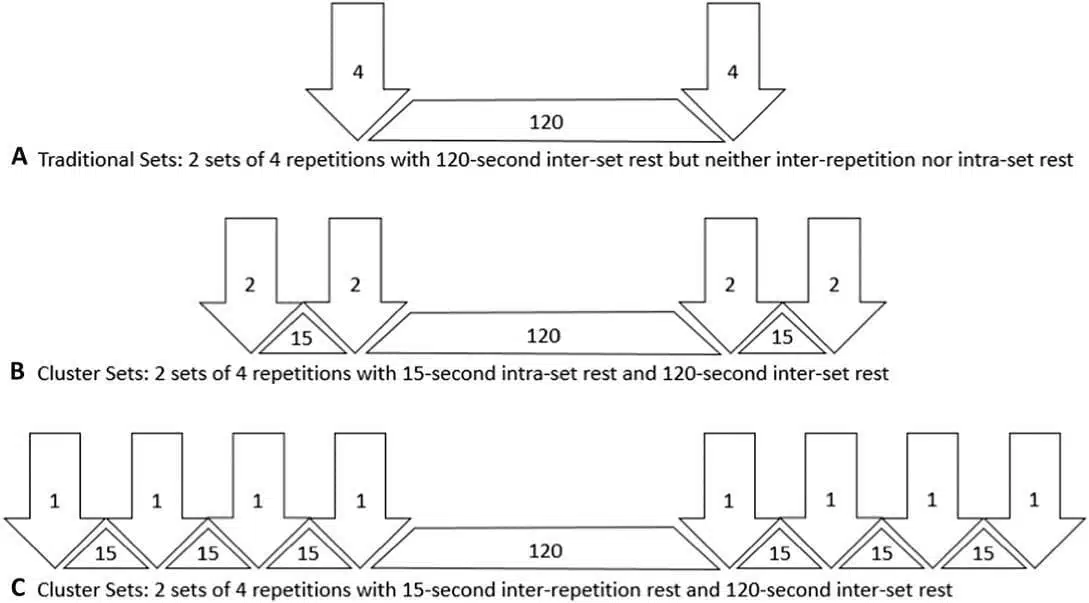21 de October de 2022
Recommended Clusters to Gain Strength and Power
Cluster method: what it consists of

The traditional method for strength training consists of performing a certain number of repetitions, followed by ample rest until a new series is performed. The cluster is a strength training methodology that introduces breaks within the same series. This technique introduces more shorter breaks within the same series, instead of grouping all the rest time when we finish that series (Hardee et al., 2013). There are two main types of cluster that interest us most for the increase of muscle mass or strength.
Rest pause
This methodology is widely known in advanced athletes of muscle hypertrophy. The objective is to introduce small breaks within the same series to be able to perform more repetitions. Thanks to the rest pause we can do more repetitions with the same weight than we would do without using this technique.
Let’s assume that you are able to perform about 15 repetitions of bench press with 100kg. A traditional series would consist of doing all those repetitions in a row and resting a few minutes once the series is finished to face the next one. With the rest pause technique what we do is split that series in fewer repetitions and we put about 20 seconds of rest between them. The series would be made as follows:
- 10 repetitions
- 20-second break
- 5 repetitions
- 20-second break
- 4 repetitions
- 20-second break
- 3 repetitions
- 20-second break
In this way we have done more repetitions with the same weight, generating a greater stimulus for muscle hypertrophy. When it comes to gaining strength there is another type of more suitable cluster that will allow us higher levels of power throughout the series, while decreasing the fatigue index (Jukic, Ramos, Helms, McGuigan, & Tufano, 2020).
Intra-series or intra-repetition rest
In these types of clusters the series is divided into as many blocks as we want, with a break in between. There are as many divisions as we want. A traditional series of six repetitions can be divided into:
- Two blocks of three repetitions with a break in between
- Three blocks of two repetitions with a break every two repetitions
- Six blocks of a repetition with a break after each repetition.
The dynamic is none other than splitting each series into different blocks instead of doing all the repetitions at once. The breaks used can also vary, but they are usually about 15 to 20 seconds, although they can be adjusted to our preferences.
How to perform the cluster method?

The weight selected for the cluster is the one we would choose for a traditional series. If we are going to perform, for example, four repetitions with 85% of 1RM, that will also be the weight for the cluster. A mistake that is usually made in introducing more weight because instead of four repetitions in a row we are going to perform two or one with short breaks. Therefore, the weight should be what we would move in a traditional series, no more.
A systematic review shows several cluster strategies that can be carried out (Tufano, Brown, & Haff, 2017). The traditional method consists of performing different sets separated by a break. The figure below exemplifies how a traditional series or a cluster series is performed.
In the traditional series we perform four repetitions in a row and rest for 120 seconds before returning to perform another series of four repetitions in a row. Instead of performing that traditional method, the cluster introduces breaks of about 15 or 20 seconds after each block of repetitions. Example “B” shows a break within the 15-second series separating two blocks of two repetitions. In this case we do two blocks of two repetitions instead of doing the four repetitions in a row. At the end of the series it rests as in the traditional method for 120 seconds and repeats again.
Example “C” introduces a break of 15 seconds after each repetition until the four repetitions of that series are completed. Therefore, in all three scenarios the same repetitions have been made, but with the cluster there have been pauses within the series.

Figure extracted from (Tufano et al., 2017)
There are as many cluster combinations as we want. The differential aspect that we must take into account is the total time of the session, since using either of the two previous examples makes the strength session longer. All force parameters are favorable when we use cluster instead of the traditional method (Latella, Teo, Drinkwater, Kendall, & Haff, 2019). In the following section we describe the main advantages of the cluster method with respect to the traditional method.
Advantages of the cluster method over traditional training

Fatigue and physiology of the cluster method
The use of more frequent and shorter breaks improves the clearance of waste metabolites, resynthesise ATP and keeps lactate levels at bay (García-Ramos et al., 2020). Phosphocreatine reserves, a key energy pathway for strength and power, will also be maintained at higher levels thanks to the use of breaks within the series (Jukic et al., 2020).
The cluster method attenuates the loss of speed, power and maximum force
When we train strength, speed and power the goal is to move the load as fast as we can. In a traditional series we lose speed as we do repetitions. In a device that measures the lifting speed we can observe how the speed at which we move the load in the first repetition is lost in the following repetitions, which means that we are accumulating fatigue (Włodarczyk, Adamus, Zieliński, & Kantanista, 2021).
An ideal strategy to prevent that from happening, and with which we cando each repetition with the highest quality, is to use the cluster technique instead of traditional training (Latella et al., 2019). We can do it in a planned way with any of the examples we have seen above, or establish a certain loss of speed from which the series stops for a few seconds and resumes again.
In either of the two ways we can see how the speed at which we move the bar remains high with the cluster method, but that decreases with the traditional method. This point in favor of the cluster is essential when training with the highest quality and minimum fatigue.
Changes in the force-speed ratio
Each sport and each person has a force-speed curve that is determined by the ability to generate force in the minimum time (a kick boxing kick) or by the ability to generate maximum force regardless of time (powerlifting lifts).
Except for pure strength sports such as powerlifting or strongman championships, we need to apply strength, but we depend on time. A successful lifting in weightlifting is determined by the speed at which we have moved the bar so that we have time to get under it. Punching with more pounds of force is useless if it’s not fast enough to hit your opponent.
To improve this application of force over time, force lifts are worked at maximum speed. The cluster allows more repetitions at maximum speed, so it is able to improve this force-velocity curve more than the traditional method. An example of this is this year’s research in which a traditional group was compared with a cluster group (Rial-Vázquez et al., 2022). The traditional group performed four sets of eight repetitions (4×8) with five minutes of rest between them. The cluster group completed 16 sets of two repetitions (16×2) with one minute of rest between sets. As usual in other research, the cluster group can modulate changes in the force-velocity ratio to a greater extent.
Subjective perception of effort
When using cluster in heavy series, the subjective perception of effort will also be more favorable than with the traditional method (Mayo, Iglesias-Soler, & Kingsley, 2019). What’s harder for you: performing three deadlift repetitions with the maximum weight for those repetitions or taking short breaks after each rep? By introducing a small pause after each repetition, or a few repetitions, we can benefit from everything discussed so far.
Joaquin Vico Plaza
Conclusions
The cluster method does nothing more than divide a traditional series into smaller blocks of repetitions, separated by short breaks of about 15 or 20 seconds, although that will depend on each coach and athlete. Thanks to this adjustment, different advantages are produced over the traditional method that maximize the adaptations of force, power and speed. There is no specific type of division for the cluster technique, but it will be the art of the trainer that establishes smaller or larger blocks, always bearing in mind that establishing breaks within the series will allow us to move the load faster and with less fatigue.
Bibliography
García-Ramos, A., González-Hernández, J. M., Baños-Pelegrín, E., Castaño-Zambudio, A., Capelo-Ramírez, F., Boullosa, D., … Jiménez-Reyes, P. (2020). Mechanical and Metabolic Responses to Traditional and Cluster Set Configurations in the Bench Press Exercise. Journal of Strength and Conditioning Research, 34(3), 663–670. https://doi.org/10.1519/JSC.0000000000002301
Hardee, J. P., Lawrence, M. M., Zwetsloot, K. A., Triplett, N. T., Utter, A. C., & McBride, J. M. (2013). Effect of cluster set configurations on power clean technique. Journal of Sports Sciences, 31(5), 488–496. https://doi.org/10.1080/02640414.2012.736633
Jukic, I., Ramos, A. G., Helms, E. R., McGuigan, M. R., & Tufano, J. J. (2020). Acute Effects of Cluster and Rest Redistribution Set Structures on Mechanical, Metabolic, and Perceptual Fatigue During and After Resistance Training: A Systematic Review and Meta-analysis. Sports Medicine (Auckland, N.Z.) , 50(12), 2209–2236. https://doi.org/10.1007/S40279-020-01344-2
Latella, C., Teo, W. P., Drinkwater, E. J., Kendall, K., & Haff, G. G. (2019). The Acute Neuromuscular Responses to Cluster Set Resistance Training: A Systematic Review and Meta-Analysis. Sports Medicine (Auckland, N.Z.) , 49(12), 1861–1877. https://doi.org/10.1007/S40279-019-01172-Z
Mayo, X., Iglesias-Soler, E., & Kingsley, J. D. (2019). Perceived Exertion Is Affected by the Submaximal Set Configuration Used in Resistance Exercise. Journal of Strength and Conditioning Research, 33(2), 426–432. https://doi.org/10.1519/JSC.0000000000001886
Rial-Vázquez, J., Mayo, X., Tufano, J. J., Fariñas, J., Rúa-Alonso, M., & Iglesias-Soler, E. (2022). Cluster vs. traditional training programmes: changes in the force-velocity relationship. Sports Biomechanics, 21(1), 85–103. https://doi.org/10.1080/14763141.2020.1718197
Tufano, J. J., Brown, L. E., & Haff, G. G. (2017). Theoretical and Practical Aspects of Different Cluster Set Structures: A Systematic Review. Journal of Strength and Conditioning Research, 31(3), 848–867. https://doi.org/10.1519/JSC.0000000000001581
Włodarczyk, M., Adamus, P., Zieliński, J., & Kantanista, A. (2021). Effects of Velocity-Based Training on Strength and Power in Elite Athletes-A Systematic Review. International Journal of Environmental Research and Public Health, 18(10). https://doi.org/10.3390/IJERPH18105257

